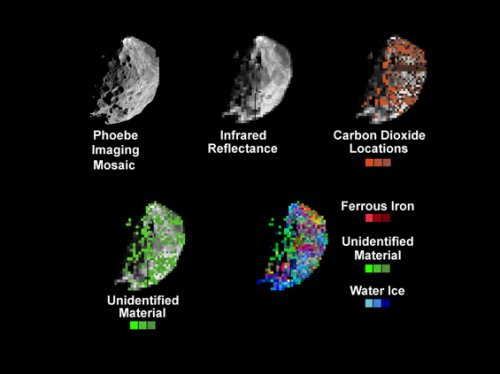Phoebe, one of the 30 Saturnian moons, has been an enigma since its discovery in 1898. Its small size, and its chaotic and distant orbit from the mother planet Saturn, gave it the image of an object accidentally caught in the area of the gas giant's gravitational influence

Phoebe, one of the 30 Saturnian moons, has been an enigma since its discovery in 1898. Its small size, and its chaotic and distant orbit from the mother planet Saturn, gave it the image of an object accidentally caught in the area of the gas giant's gravitational influence.
New information, provided by the Cassini spacecraft, which passed by the region on June 11, could solve the mystery. Data analysis with the help of spectrometric mapping in the visible and infrared (Visual and Infrared Mapping Spectrometer - VIMS), indicates that Phoebe is an ancient mixture of ice, rock and carbon. These components, also known as "Icy Planetesimals", were the building blocks of the outer part of the solar system 4.5 billion years ago. Most of them were assimilated into the cores of the gas giants, but some remained in the Kuiper Belt - with the ruins of comets whose orbit is located beyond Neptune. Scientists believe that Phoebe drifted into orbit around Saturn during the planet's formation, and has remained there ever since.
The spectral measurements of the moon confirm the presence of frozen water and the presence of carbon dioxide and liquid carbon similar to those found on ancient meteorites. In addition, the findings show a clear chemical similarity between the materials on Phoebe and those that make up comets.
Thanks to Cassini's findings, it was determined with certainty that the density of the moon is 1.6 grams per cubic centimeter - lighter than average rock but heavier than pure ice. This fact could indicate a similarity between the composition of Phoebe and Pluto and its moon Charon, which are also considered to be objects detached from the Kuiper Belt.
The average daytime temperature on Phoebe is around minus 163 degrees Celsius, and even lower at night. The reason for this can lie in the nature of the ground surface which is covered with several millimeters of thin dust and ice particles.
Phoebe's surface scan, using the Composite Infra-Red Spectrometer (CIRS), shows the moon as "a very complex object, with a varied topography. "Phoebe was badly "eaten", probably by meteorites that collided with it", said John Pearl, a partner in the CIRS research.
Dennis Mattson, Cassini Project Scientist, says: "For the first time, we have completed an analysis of a resident of the outer region of the Solar System that is close to bodies in the Kuiper belt. During two short weeks we revealed more information than we knew about Phoebe for the last hundred years since its discovery."
